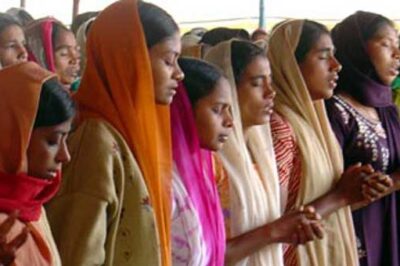A Legacy of Persecution
It’s no surprise that India is a dangerous place to preach the gospel. (Many historians say the apostle Thomas was either lanced or stoned by angry locals after he landed in Kodungallur, in the state of Kerala, in the first century.) The Pakistani terrorists who bombed hotels in Mumbai in November 2008, killing 173, reminded the world that religious and political tensions are seething under the façade of India’s booming economy and technological progress.
The Mumbai incident captured headlines around the world. But the media paid little attention to the religious violence that erupted in late 2007, and again in the summer of 2008, in Orissa, an economically depressed state in the north central region where Christianity has been growing rapidly.
One of the most widely publicized incidents of martyrdom in recent history occurred in Orissa. Australian missionary Graham Staines, who worked with Indian lepers, was murdered there in 1999 with his two young boys. Crazed Hindu militants set Staines’ vehicle on fire and burned the three alive.
Hindu mobs, energized by the radical Bharatiya Janata political party, went on more rampages last year-burning churches, leveling homes, raping nuns, and, in some cases, cutting Christians to pieces with machetes or burning them alive. As many as 118 died in the recent Orissa attacks, and local government officials were slow to quell the unrest. The violence spread to other states, including Karnataka and even Kerala, which has India’s largest Christian population.
John Dayal, an Indian activist who founded the All India Christian Council, says what happened in Orissa is part of a 50-year hate campaign waged by nationalistic Hindus who draw inspiration from the Nazis of Germany. They believe India is a Hindu country, and they will go to any means necessary to defend the Hindu caste system-which keeps poor people locked at the bottom of society.
“The violence in August and September 2008 has been the worst in our 2,000-year history in India,” Dayal says. “More than 50,000 [Christians] were homeless and more than 30,000 were hiding in forests, chased like animals by fanatics who were forcing them to become Hindus or die.”
Why the harsh violence? Indian church planter P.G. Vargis told missionary journalist John Lindner in August that the attacks against Christians were retaliatory strikes-aimed at wiping out the churches in Orissa because of extraordinary growth in recent years. Vargis said that when his ministry, the Indian Evangelical Team (IET), first went to Orissa there were hardly any evangelical churches there.
“Today it is difficult to travel 50 miles in this part of Orissa without encountering an IET church,” Vargis says. “As of 2007, we had planted more than 1,000 pioneer churches in Orissa.”
Other church leaders confirmed that the number of Christians has grown exponentially in Orissa, and they accuse the Indian government of hiding statistics. “Orissa was once completely unreached, but today as many as 28 percent of the people are Christians,” one pastor told Charisma.
Jeet, a 29-year-old pastor, knows what it means to be persecuted for his faith. He grew up in Orissa’s capital, Bhubaneshwar, but his parents kicked him out of his home at age 17 when they realized he would no longer make sacrifices to a Hindu snake god. He finally admitted that he had converted to Christ through the influence of a friend.
Jeet’s father told him he could return home when he was ready to renounce Jesus. The young man has not been home in 14 years. He started a church in a nearby village, and he has a goal of evangelizing the 56 unreached tribes in the region. He has been threatened numerous times by Hindu mobs.
Says Jeet: “They tell me, ‘There is no need to preach Jesus here! We are all Hindus!’ And I tell them, ‘It is the commandment of Jesus Christ that I preach to all people!’ “
Larry Derstine, an American who has ministered with his wife in north India since 1989 (and was forced to evacuate in September because of the Orissa violence), said almost all Christians he knows there have been persecuted. It is simply the price they pay to follow Jesus.
“They are resilient,” he says of these brave believers. “They are crushed, but they bounce back. We give them just a little bit of training and they go a long way.”
Dismantling the Caste System
Christianity is unraveling a foundational tenet of Indian culture-the idea that people are categorized by caste. Hinduism teaches that there are four castes-Brahmins (priests), Kshtriyas (rulers), Vaishyas (merchants) and Shudras (laborers)-and that below these people are the Dalits, also known as the “untouchables.”
Today the gospel is extremely attractive to these 360 million Dalits, who for centuries have been denied social privileges, including access to water. The poorest of the poor, they have been told they are less valuable than animals. Although discrimination based on caste has been officially outlawed in India, most Dalits still lack educational and economic opportunities.
Radical Hindus want to keep Dalits in their place to preserve traditional social order. But in recent years, hundreds of thousands of Dalits have found Christ-and in the gospel they discovered the self-empowerment, personal liberty and human dignity that Hinduism denied them. As the Dalit Christian movement grew, radical Hindus tried to prevent conversions.
Indian missions strategist Joseph D’Souza, director of Operation Mobilization in Hyderabad, says the amazing trend of Dalit evangelism is single-handedly transforming his nation. “The Dalit struggle for freedom is gaining strength, and their oppressors do not want them to go free,” D’Souza says. “India will soon go through a massive spiritual change, and this will match what God is doing in China.”
D’Souza also directs the Dalit Freedom Network, which has raised global awareness of Dalit oppression. He says church growth among Dalits is not only upsetting upper-caste Hindu extremists but also some Christians in the south of India who are “caste infected.” Some Christians, he says, “do not see that the gospel and caste cannot go together.”
Throughout India today, growing Pentecostal and charismatic churches are trumpeting the biblical idea that all people are created equal. It’s a radical concept in this ancient land shaped by caste values.
“In Christ there is no Brahmin or Dalit, literate or illiterate, no rich or poor,” says Shekhar Kallianpur, pastor of the New Life Fellowship in Mumbai. A former Hindu Brahmin himself, he was converted to Christ 30 years ago and is a thorn in the side of Hindu extremists.
Says Kallianpur: “A Dalit’s decision to follow Christ brings the kingdom value that there is no Greek or Jew, Brahmin or Shudra, black or white, but we are all one in Christ. This powerful transformation, spread through word of mouth, has become a major movement in our nation.”
Paul Thangiah is pastor of the 15,000-member Full Gospel Assembly of God Church in Bengaluru (Bangalore), India’s third most populous city. He compares the caste system to the problem of racial prejudice in the United States and believes the Indian church is overcoming it.
“Caste has strong and deep roots in the very being of India,” Thangiah says. “But Pentecostal churches in India, under the anointing of the Holy Spirit, do not support or encourage the caste system. The gospel transforms people from different castes into one caste.”






Leave a Comment
You must be logged in to post a comment.